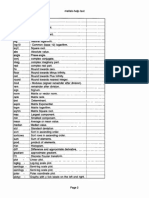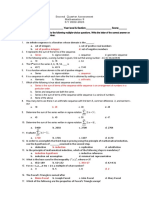0 ratings0% found this document useful (0 votes)
351 viewsComplex Numbers Using Excel
The document discusses the 18 complex functions in Excel including COMPLEX, IMABS, IMAGINARY, IMARGUMENT, and IMCONJUGATE. It provides the syntax and examples of using each function to perform operations on and analyze complex numbers in Excel. The functions allow users to transform real and imaginary coefficients into complex numbers, calculate the absolute value, imaginary coefficient, argument, and conjugate of complex numbers, and perform operations like exponentiation, logarithms, trigonometry, products, sums, and differences on complex numbers.
Uploaded by
Marlena RossCopyright
© © All Rights Reserved
Available Formats
Download as PDF, TXT or read online on Scribd
0 ratings0% found this document useful (0 votes)
351 viewsComplex Numbers Using Excel
The document discusses the 18 complex functions in Excel including COMPLEX, IMABS, IMAGINARY, IMARGUMENT, and IMCONJUGATE. It provides the syntax and examples of using each function to perform operations on and analyze complex numbers in Excel. The functions allow users to transform real and imaginary coefficients into complex numbers, calculate the absolute value, imaginary coefficient, argument, and conjugate of complex numbers, and perform operations like exponentiation, logarithms, trigonometry, products, sums, and differences on complex numbers.
Uploaded by
Marlena RossCopyright
© © All Rights Reserved
Available Formats
Download as PDF, TXT or read online on Scribd
You are on page 1/ 4
10.
3 Complex functions in EXCEL
Now, lets look at the list in Table 10-1. This shows the 18 complex functions in
EXCEL. Well examine the usage, syntax, and some examples of these functions.
Table 10-1. Complex Functions in EXCEL
COMPLEX IMABS IMAGINARY IMARGUMENT
IMCONJUGATE IMCOS IMDIV IMEXP
IMLN IMLOG10 IMLOG2 IMPOWER
IMPRODUCT IMREAL IMSIN IMSQRT
IMSUB IMSUM
COMPLEX
This transforms real and imaginary coefficients into a complex number of the
form x + yi or x + yj.
Syntax: COMPLEX(real_num,i_num,suffix)
Suffix must be i or j. Dont use upper case!
Examples: COMPLEX(3,4) equals 3 + 4i
COMPLEX(3,4,"j") equals 3 + 4j
COMPLEX(0,1) equals i
COMPLEX(1,0) equals 1
IMABS
Returns the absolute value (modulus) of a complex number in x + yi or x + yj text
format.
Syntax: IMABS(inumber)
inumber is a complex number for which you want the absolute value.
Example: IMABS("3+4i") equals 5. Note that "3+4i" is in text form, not numeric
form. Complex numbers are not numerics in EXCEL.
IMAGINARY
Returns the imaginary coefficient of a complex number in x + yi or x + yj text
format.
Syntax: IMAGINARY(inumber)
inumber is a complex number for which you want the imaginary coefficient.
Examples: IMAGINARY("3+4i") equals 4
IMAGINARY("0-j") equals -1
10.3 Complex functions in Excel 10-7
IMAGINARY(4) equals 0
IMARGUMENT
Returns the argument (), an angle expressed in radians.
Syntax: IMARGUMENT(inumber)
inumber is a complex number for which you want the argument .
Example: IMARGUMENT("3+4i") equals 0.927295
IMCONJUGATE
Returns the complex conjugate of a complex number in x + yi or x + yj text format.
All complex numbers are in text format.
Syntax: IMCONJUGATE(inumber)
inumber is a complex number for which you want the conjugate.
Example: IMCONJUGATE("3+4i") equals 34i
IMCOS
Returns the cosine of a complex number in x + yi or x + yj text format.
Syntax: IMCOS(inumber)
inumber is a complex number for which you want the cosine.
Example: IMCOS("1+i") equals 0.83373 - 0.988898i
(Note that the cosine of a complex number is complex.)
IMDIV
Returns the quotient of two complex numbers in x + yi or x + yj text format.
Syntax: IMDIV(inumber1,inumber2)
inumber1 is the complex numerator or dividend.
inumber2 is the complex denominator or divisor.
Example: IMDIV("-238+240i","10+24i") equals 5 + 12i
IMEXP
Returns the exponential of a complex number in x + yi or x + yj text format.
Syntax: IMEXP(inumber)
inumber is a complex number for which you want the exponential.
Example: IMEXP("1+i") equals 1.468694 + 2.287355i
IMLN
Returns the natural logarithm of a complex number in x + yi or x + yj text format.
Syntax: IMLN(inumber)
inumber is a complex number for which you want the natural logarithm.
Example: IMLN("3+4i") equals 1.609438 + 0.927295I
IMLOG10
Returns the common logarithm (base 10) of a complex number in x + yi or
10-8 Chapter 10: Complex Math
x + yj text format.
Syntax: IMLOG10(inumber)
inumber is a complex number for which you want the common logarithm.
Example: IMLOG10("3+4i") equals 0.69897 + 0.402719i
IMLOG2
Returns the base-2 logarithm of a complex number in x + yi or x + yj text format.
Syntax: IMLOG2(inumber)
inumber is a complex number for which you want the base-2 logarithm.
Example: IMLOG2("3+4i") equals 2.321928 + 1.337804i
IMPOWER
Returns a complex number in x + yi or x + yj text format raised to a power.
Syntax IMPOWER(inumber,number)
inumber is a complex number you want to raise to a power.
number is the power to which you want to raise the complex number.
Example: IMPOWER("2+3i", 3) equals 4 6 + 9i
IMPRODUCT
Returns the product of 2 to 29 complex numbers in x + yi or x + yj text format.
Syntax: IMPRODUCT(inumber1,inumber2,...)
inumber1, inumber2, are 1 to 29 complex numbers to multiply.
Examples: IMPRODUCT("3+4i","5-3i") equals 27 + 11i
IMPRODUCT("1+2i",30) equals 30 + 60i
IMREAL
Returns the real coefficient of a complex number in x + yi or x + yj text format.
Syntax: IMREAL(inumber)
inumber is a complex number for which you want the real coefficient.
Example: IMREAL("10-9i") equals 6
IMSIN
Returns the sine of a complex number in x + yi or x + yj text format.
Syntax: IMSIN(inumber)
inumber is a complex number for which you want the sine.
Example: IMSIN("3+4i") equals 3.853738 2 7.016813i
IMSQRT
Returns the square root of a complex number in x + yi or x + yj text format.
Syntax: IMSQRT(inumber)
inumber is a complex number for which you want the square root.
Example: IMSQRT("1+i") equals 1.098684 + 0.45509I
10.4 Graphing a complex function 10-9
IMSUB
Returns the difference of two complex numbers in x + yi or x + yj text format.
Syntax: IMSUB(inumber1,inumber2)
inumber1 is the complex number from which to subtract inumber2.
inumber2 is the complex number to subtract from inumber1.
Example: IMSUB("13+4i","5+3i") equals 8 + i
IMSUM
Returns the sum of two or more complex numbers in x + yi or x + yj text format.
Syntax: IMSUM(inumber1,inumber2,...)
inumber1,inumber2,...are 1 to 29 complex numbers to add.
Example: IMSUM("3+4i","5-3i") equals 8 + i
From EXECL for Engineers and Scientists, S.C.Bloch, 2
nd
edition, Wiley Press
You might also like
- R6: Complex Numbers and More Quadratic Equations: Tze Ru - Si FiNo ratings yetR6: Complex Numbers and More Quadratic Equations: Tze Ru - Si Fi9 pages
- UNIT-3_MATLAB PROGRAMMING_QUESTION BANK_SOLUTION (1)No ratings yetUNIT-3_MATLAB PROGRAMMING_QUESTION BANK_SOLUTION (1)15 pages
- 4.6 Perform Operations With Complex NumbersNo ratings yet4.6 Perform Operations With Complex Numbers19 pages
- Complex Number Calculations, Including With ExcelNo ratings yetComplex Number Calculations, Including With Excel2 pages
- Excel Engg Functions:: Function DescriptionNo ratings yetExcel Engg Functions:: Function Description2 pages
- Microsoft PowerPoint - 1 - Programming With MATLABNo ratings yetMicrosoft PowerPoint - 1 - Programming With MATLAB12 pages
- 4-4 Study Guide and Intervention: Complex NumbersNo ratings yet4-4 Study Guide and Intervention: Complex Numbers2 pages
- Laboratory Activity 1 - Introduction To MATLAB (Part1)No ratings yetLaboratory Activity 1 - Introduction To MATLAB (Part1)8 pages
- Laboratory Work #1 Researching Interface of The MATLAB, Working With Numbers and Arrays, Plotting 1d FunctionsNo ratings yetLaboratory Work #1 Researching Interface of The MATLAB, Working With Numbers and Arrays, Plotting 1d Functions16 pages
- Universidad Católica Santa María: Facultad de Ciencias e Ingenierías Físicas y FormalesNo ratings yetUniversidad Católica Santa María: Facultad de Ciencias e Ingenierías Físicas y Formales17 pages
- Presentation Title: Your Contact InformationNo ratings yetPresentation Title: Your Contact Information2 pages
- Encyclopedia of Computer Science and Engineering100% (3)Encyclopedia of Computer Science and Engineering1,770 pages
- CCDPS GZB: Summer Break Assignment For Class XII StudentsNo ratings yetCCDPS GZB: Summer Break Assignment For Class XII Students4 pages
- Practice Test Paper Functions Limits Continuity Differentiability Indefinite Integrals - Iit LevelNo ratings yetPractice Test Paper Functions Limits Continuity Differentiability Indefinite Integrals - Iit Level4 pages
- Robust Control and Filtering For Time Delay Systems Automation and Control Engineering50% (2)Robust Control and Filtering For Time Delay Systems Automation and Control Engineering449 pages
- Deep Learning in Neural Networks: An OverviewNo ratings yetDeep Learning in Neural Networks: An Overview31 pages
- 13.2.6 - Exact Equations and Integrating FactorsNo ratings yet13.2.6 - Exact Equations and Integrating Factors17 pages
- 1220 Number Theory Problems - Third Edition100% (1)1220 Number Theory Problems - Third Edition165 pages
- Comparative Study of K-Means and Hierarchical Clustering TechniquesNo ratings yetComparative Study of K-Means and Hierarchical Clustering Techniques7 pages
- R6: Complex Numbers and More Quadratic Equations: Tze Ru - Si FiR6: Complex Numbers and More Quadratic Equations: Tze Ru - Si Fi
- UNIT-3_MATLAB PROGRAMMING_QUESTION BANK_SOLUTION (1)UNIT-3_MATLAB PROGRAMMING_QUESTION BANK_SOLUTION (1)
- Microsoft PowerPoint - 1 - Programming With MATLABMicrosoft PowerPoint - 1 - Programming With MATLAB
- Laboratory Activity 1 - Introduction To MATLAB (Part1)Laboratory Activity 1 - Introduction To MATLAB (Part1)
- Laboratory Work #1 Researching Interface of The MATLAB, Working With Numbers and Arrays, Plotting 1d FunctionsLaboratory Work #1 Researching Interface of The MATLAB, Working With Numbers and Arrays, Plotting 1d Functions
- Universidad Católica Santa María: Facultad de Ciencias e Ingenierías Físicas y FormalesUniversidad Católica Santa María: Facultad de Ciencias e Ingenierías Físicas y Formales
- An Introduction to Elementary Algebra Part 1From EverandAn Introduction to Elementary Algebra Part 1
- CCDPS GZB: Summer Break Assignment For Class XII StudentsCCDPS GZB: Summer Break Assignment For Class XII Students
- Practice Test Paper Functions Limits Continuity Differentiability Indefinite Integrals - Iit LevelPractice Test Paper Functions Limits Continuity Differentiability Indefinite Integrals - Iit Level
- Robust Control and Filtering For Time Delay Systems Automation and Control EngineeringRobust Control and Filtering For Time Delay Systems Automation and Control Engineering
- Comparative Study of K-Means and Hierarchical Clustering TechniquesComparative Study of K-Means and Hierarchical Clustering Techniques



































































































